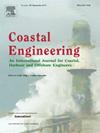减轻受滋养海滩风沙侵蚀的架构
IF 4.5
2区 工程技术
Q1 ENGINEERING, CIVIL
引用次数: 0
摘要
海滩营养已成为世界各地广泛采用的以自然为基础的海岸保护策略。然而,在易受强风影响的地区,由海滩营养物引起的地形变化——特别是营养物升高的护堤——可以显著改变近地面风场和风成沙运输过程。本研究将野外观测与数值模拟相结合,研究由海滩营养引起的地形变化如何影响海岸风成沙输运机制。主要研究结果如下:(1)高架堤导致局部性风速增大和分段风沙系统,其中分段风沙系统对风沙流的发育和输运起主导作用;(2)通过综合考虑风增强的输运刺激效应和营养化堤引起的分段输运限制效应的相互作用,提出了营养化海滩风沙输运的“分段”模式框架,显著提高了数值模拟的精度;(3)基于改进的沙输运模型,讨论了多风海岸的最优海滩营养设计,并建议采用多层机械分级的护堤营养方法,以最大限度地减少海滩表面的风沙输运。本文章由计算机程序翻译,如有差异,请以英文原文为准。
A framework to mitigate aeolian erosion on nourished beaches
Beach nourishment has become a widely adopted nature-based strategy for coastal protection worldwide. However, in regions prone to strong winds, the topographic changes induced by beach nourishment—particularly elevated nourished berms—can significantly alter near-surface wind fields and aeolian sand transport processes. This study integrates field observations with numerical modeling to examine how topographic modifications induced by beach nourishment can influence the coastal aeolian sand transport mechanisms. The key findings are as follows: (1) The elevated beach berms lead to a localized increase in wind speed and a segmented fetch system, with the latter plays a dominant role in limiting the development and transport of aeolian sand streamers; (2) By incorporating the interactions between the transport-stimulated effect of wind intensification and the transport-limited effect of fetch segmentation induced by nourished berm, a “piecewise” model framework was proposed for the aeolian sand transport of nourished beaches, which significantly improving the accuracy of numerical modeling; (3) Based on the improved sand transport model, an optimal beach nourishment design for windy coasts was discussed, and a multi-tiered, mechanically graded berm nourishment approach was recommended to minimize the aeolian sand transport across beach surface.
求助全文
通过发布文献求助,成功后即可免费获取论文全文。
去求助
来源期刊

Coastal Engineering
工程技术-工程:大洋
CiteScore
9.20
自引率
13.60%
发文量
0
审稿时长
3.5 months
期刊介绍:
Coastal Engineering is an international medium for coastal engineers and scientists. Combining practical applications with modern technological and scientific approaches, such as mathematical and numerical modelling, laboratory and field observations and experiments, it publishes fundamental studies as well as case studies on the following aspects of coastal, harbour and offshore engineering: waves, currents and sediment transport; coastal, estuarine and offshore morphology; technical and functional design of coastal and harbour structures; morphological and environmental impact of coastal, harbour and offshore structures.
 求助内容:
求助内容: 应助结果提醒方式:
应助结果提醒方式:


